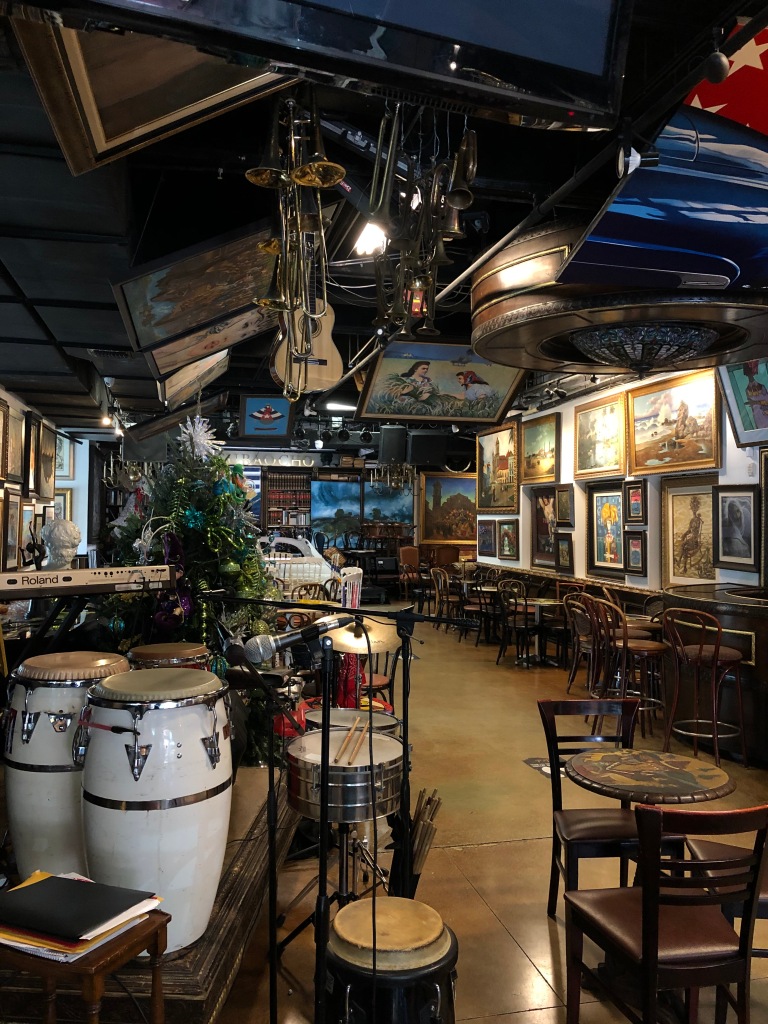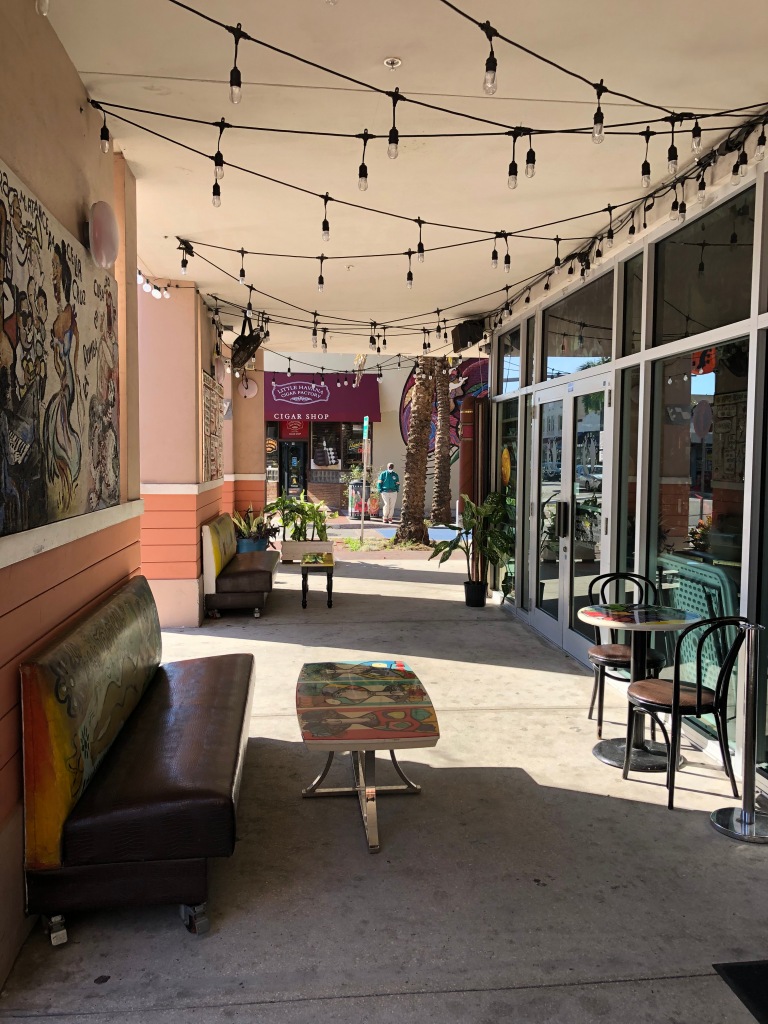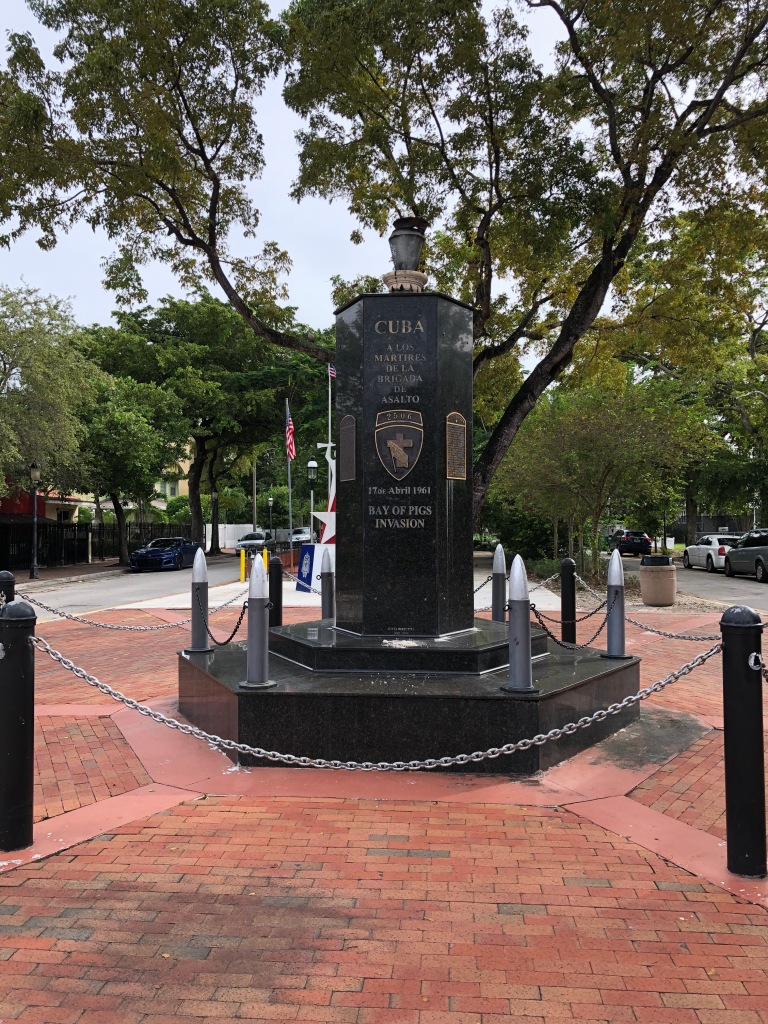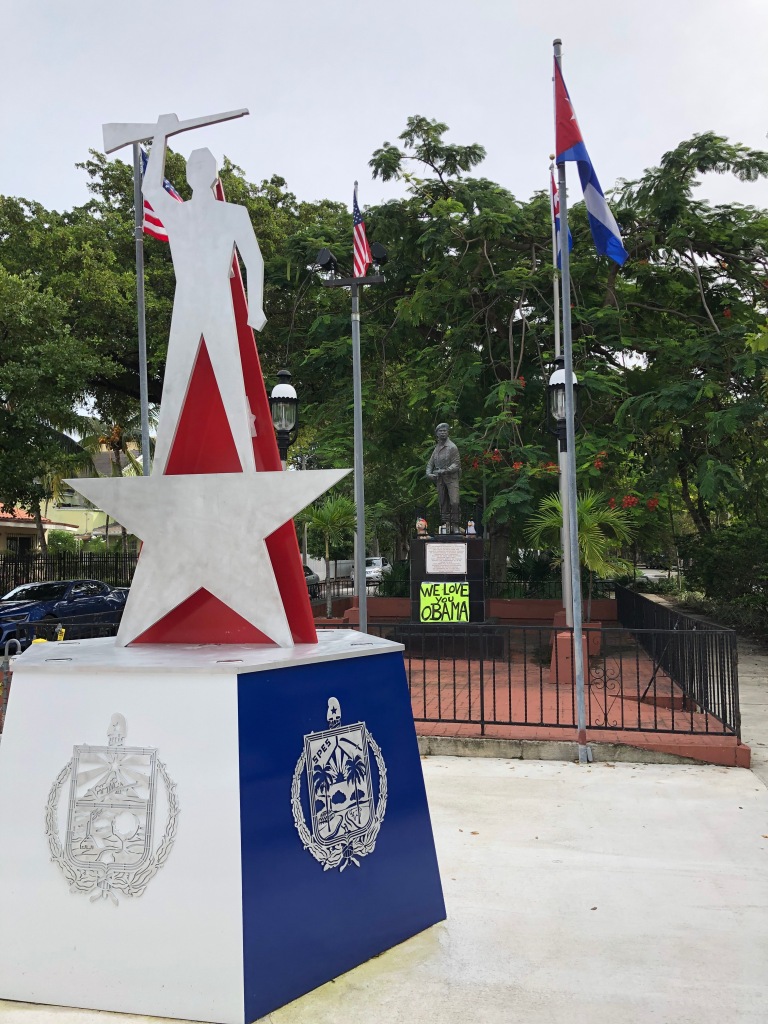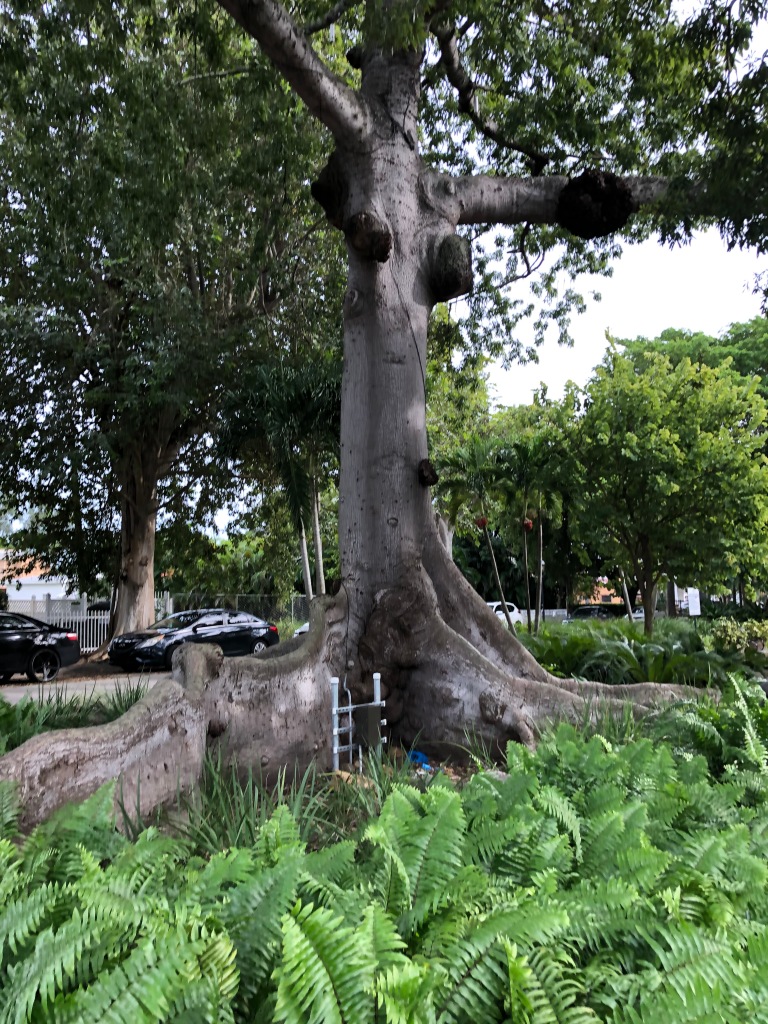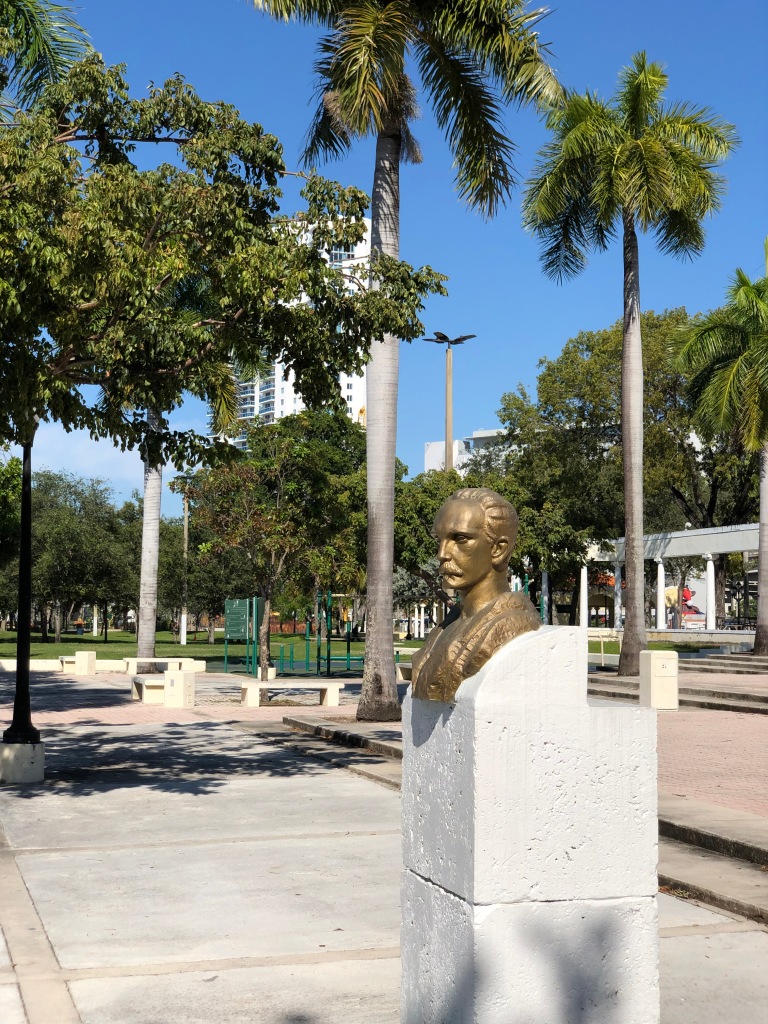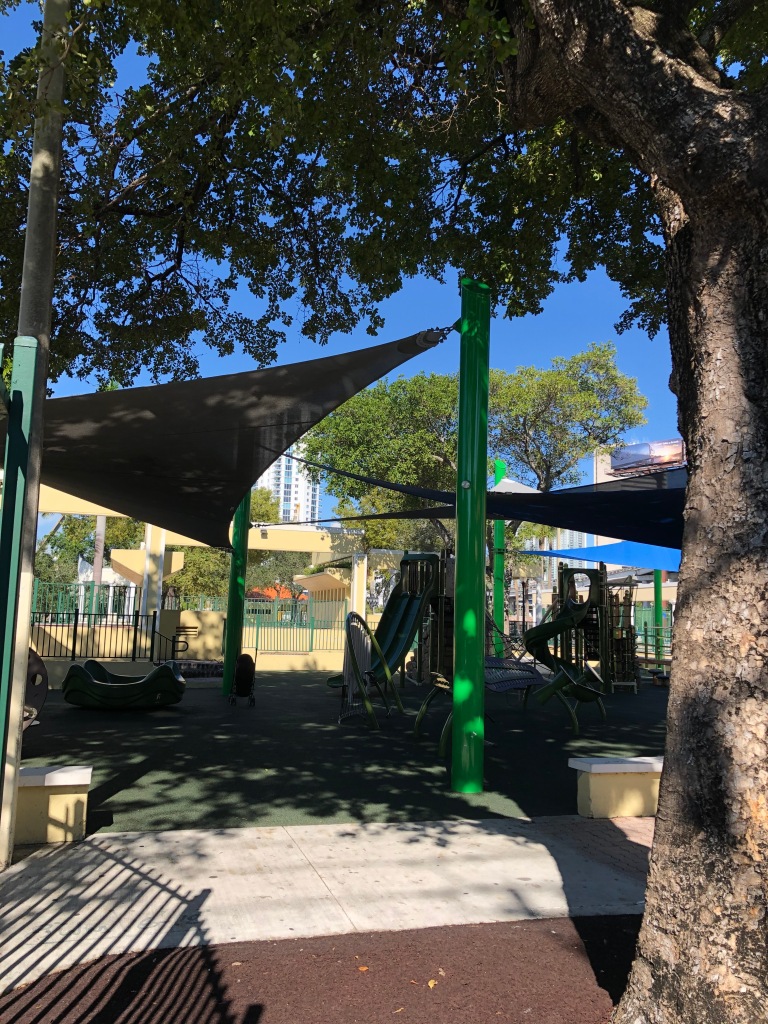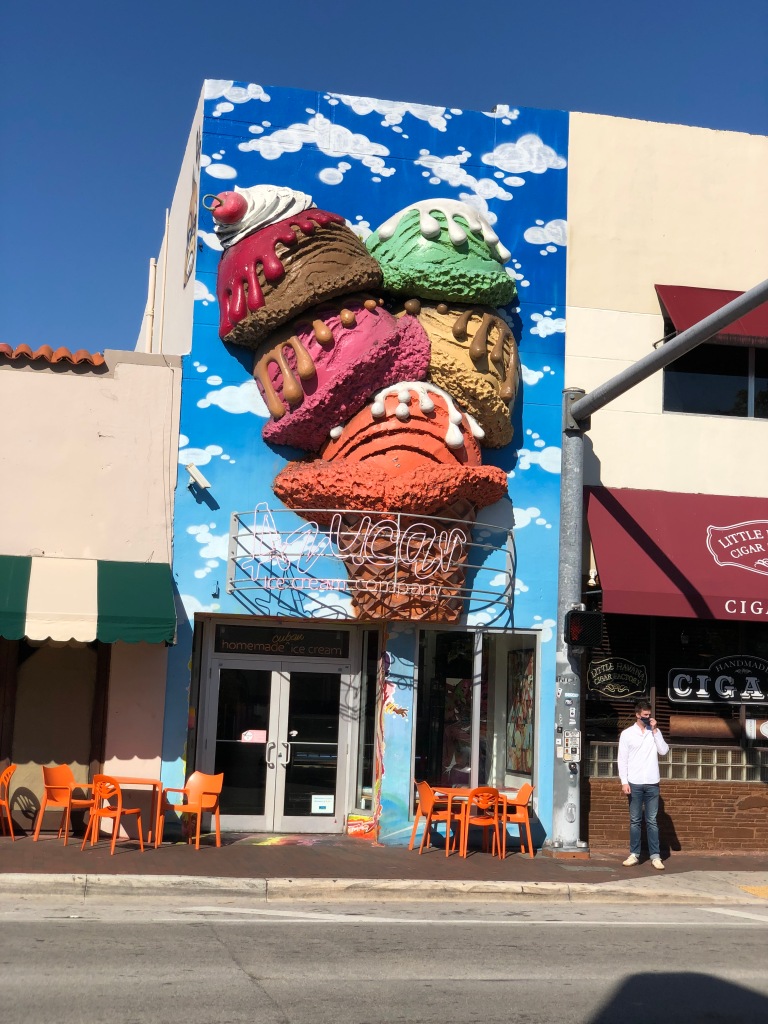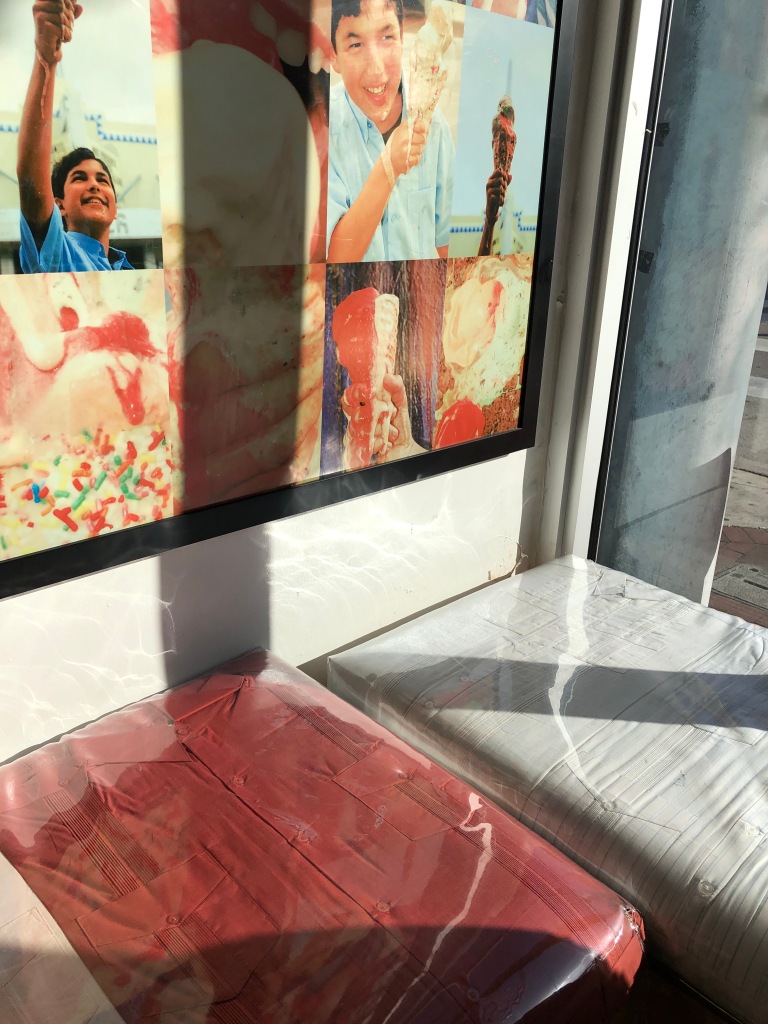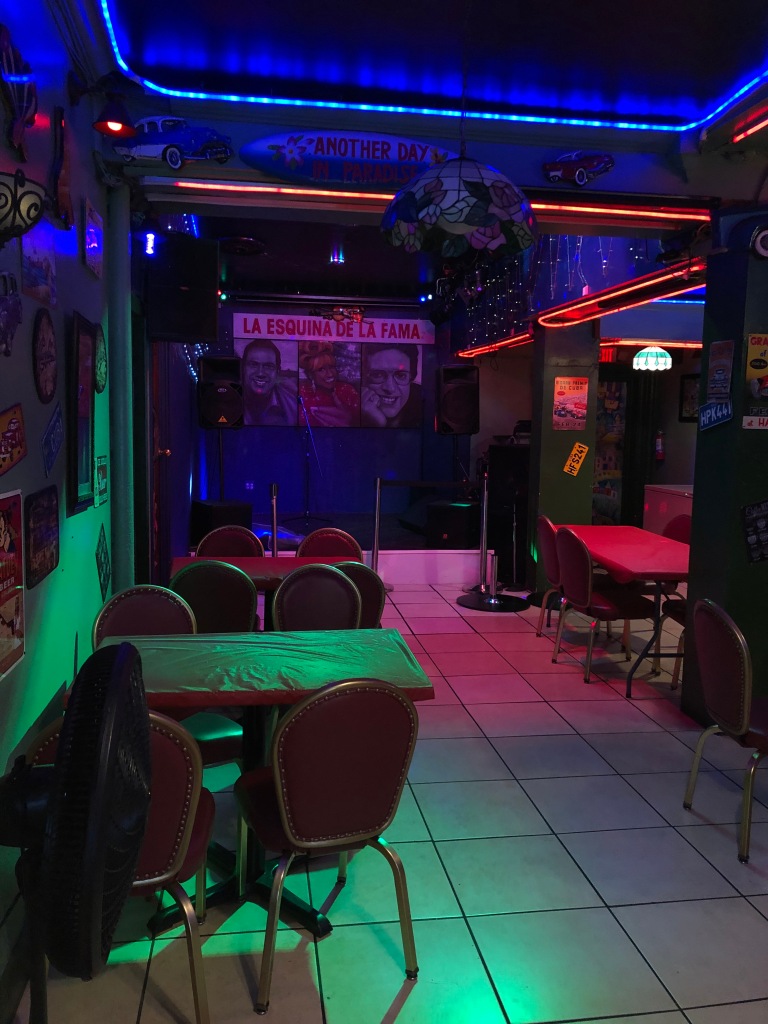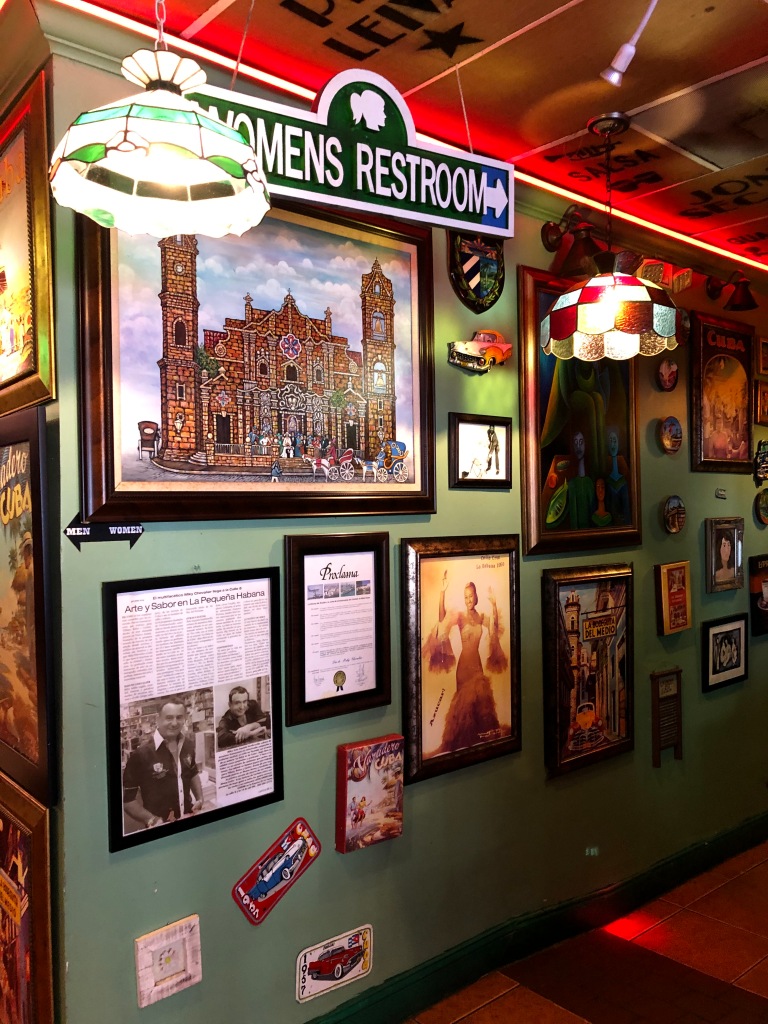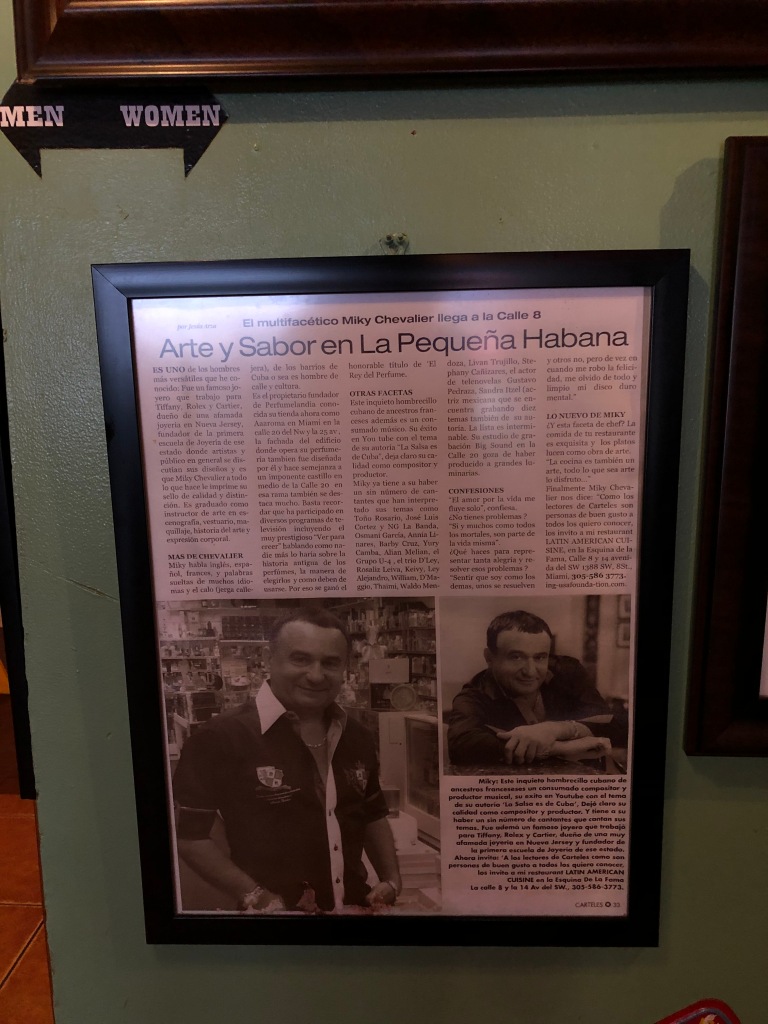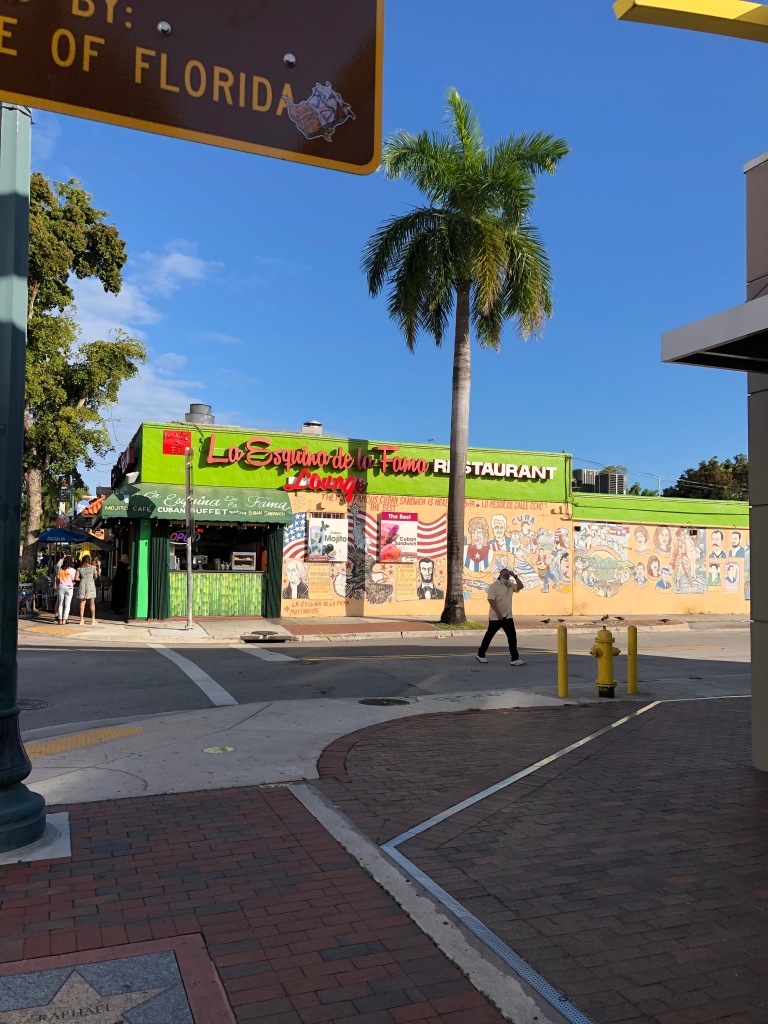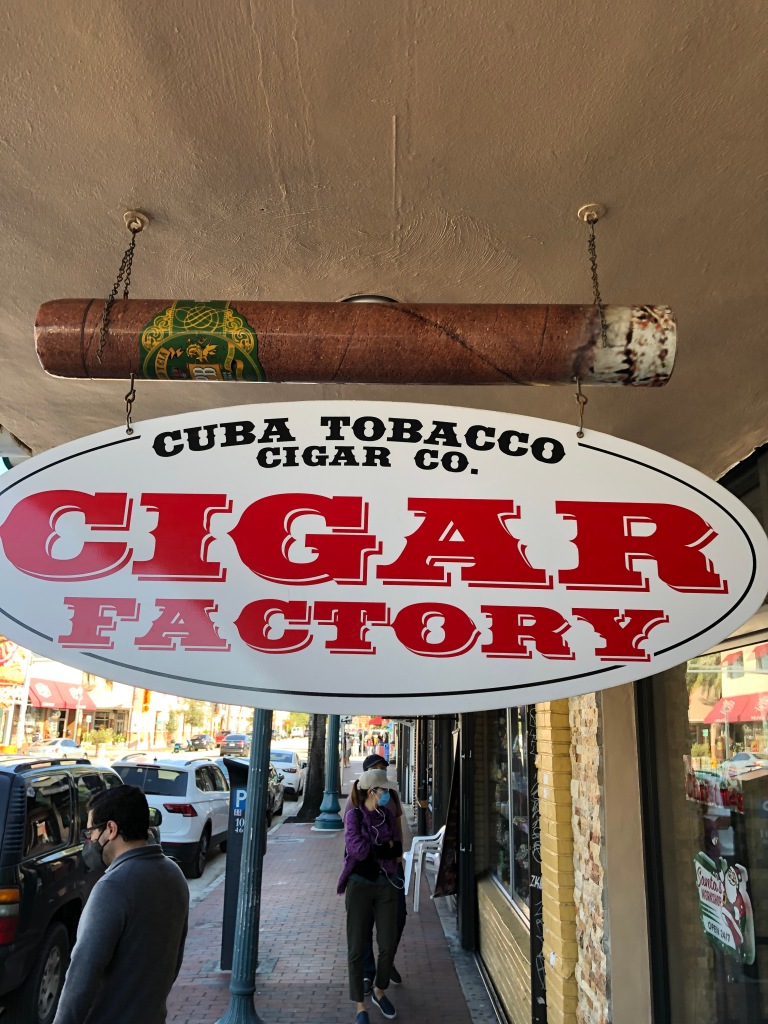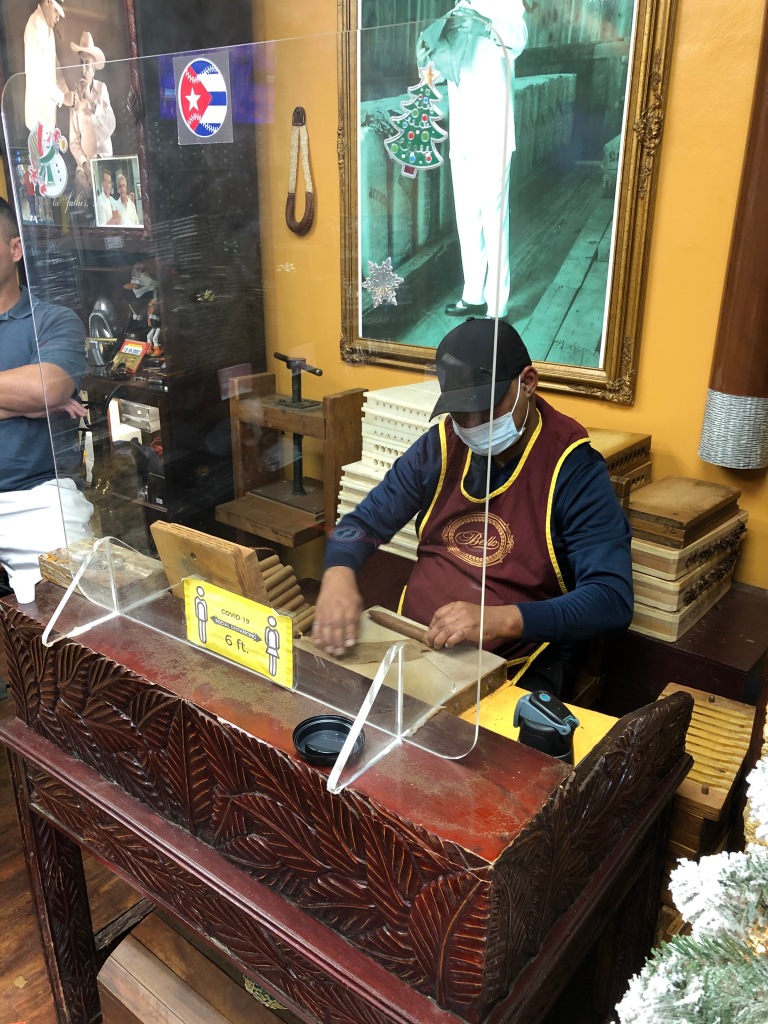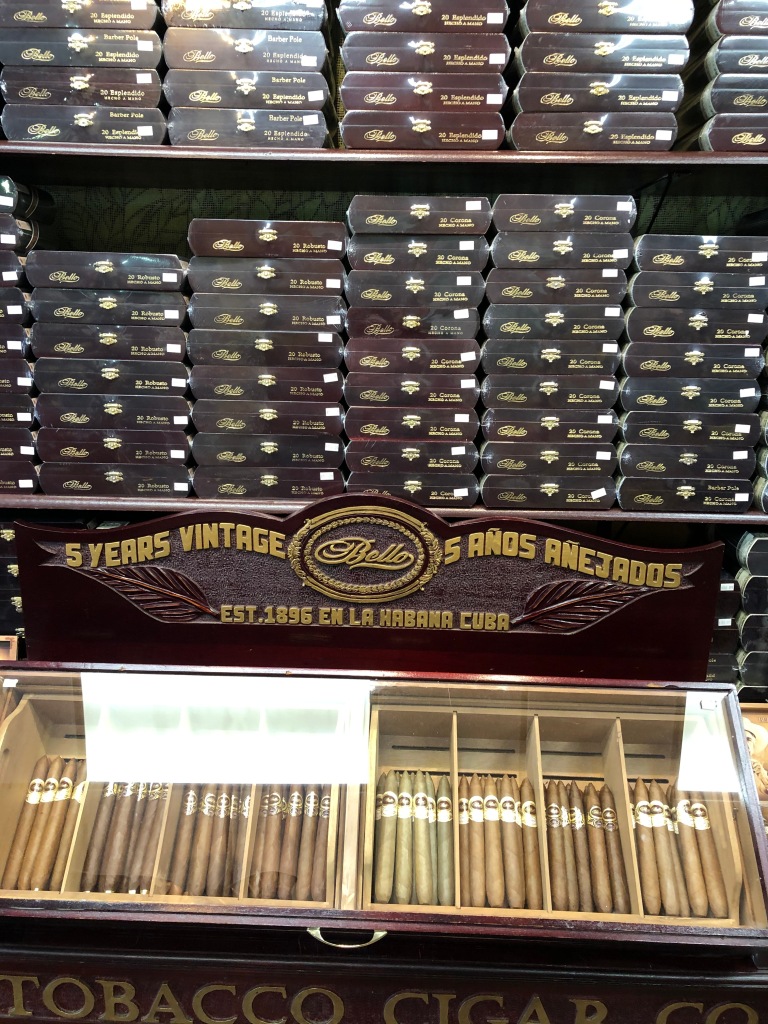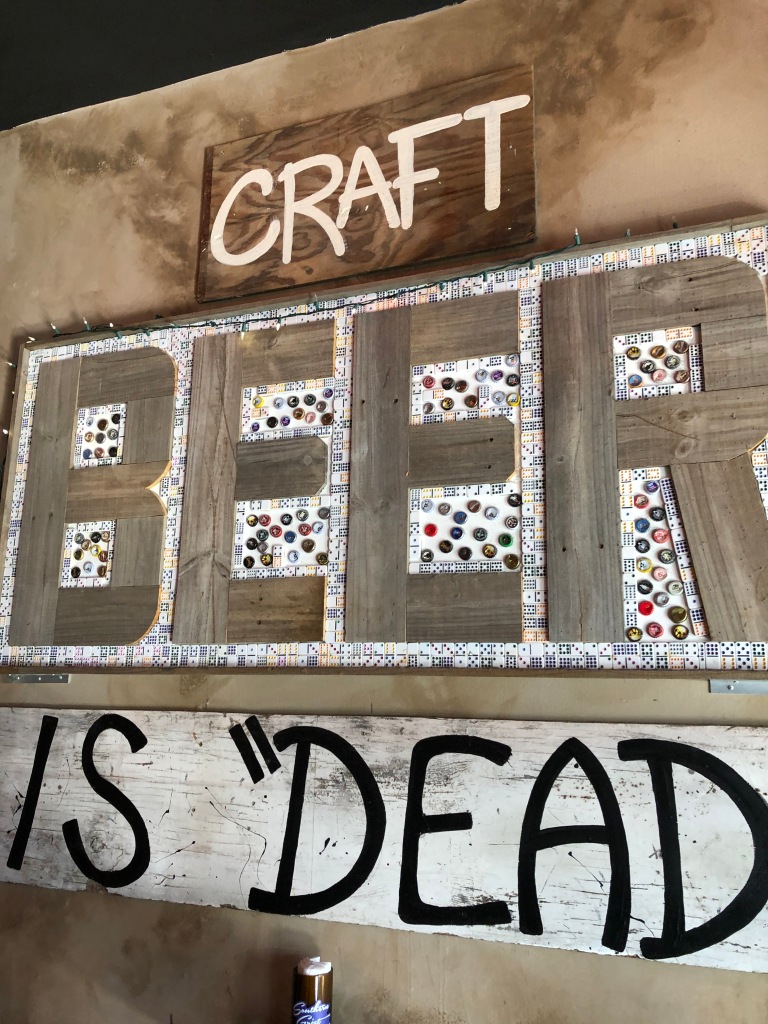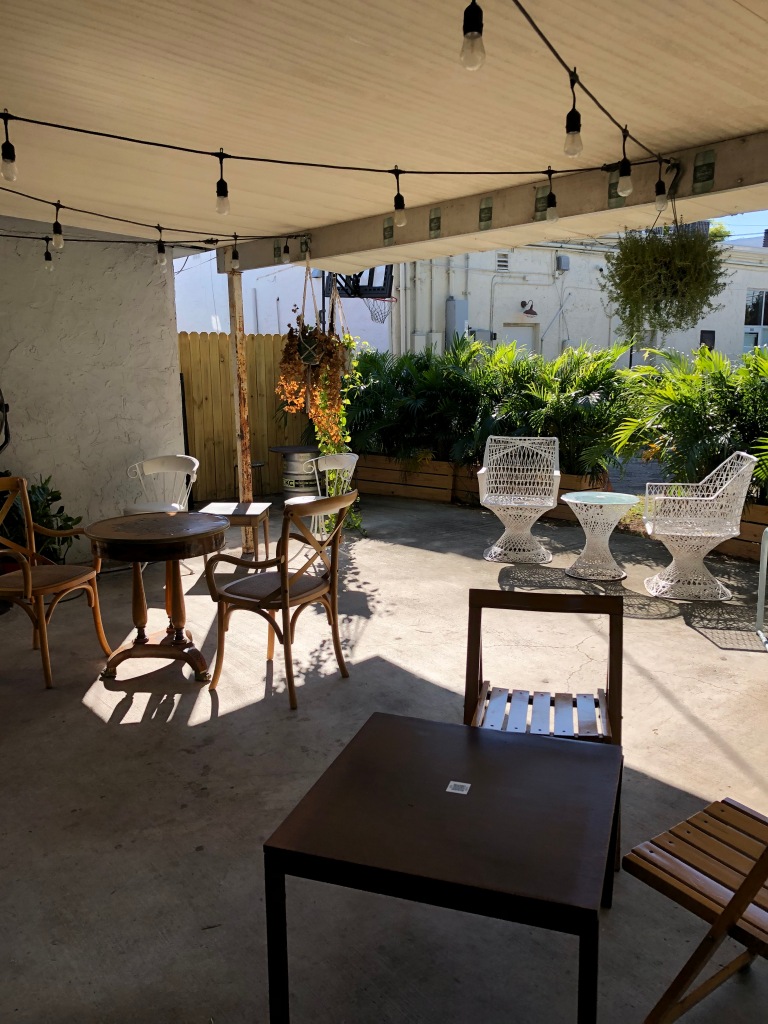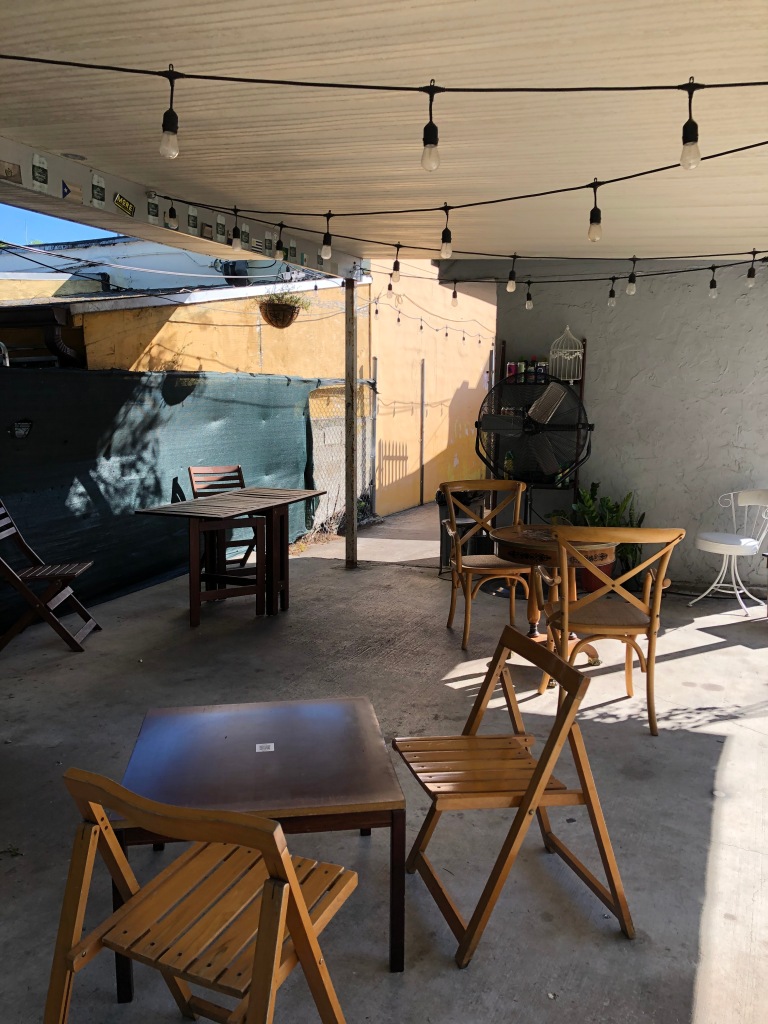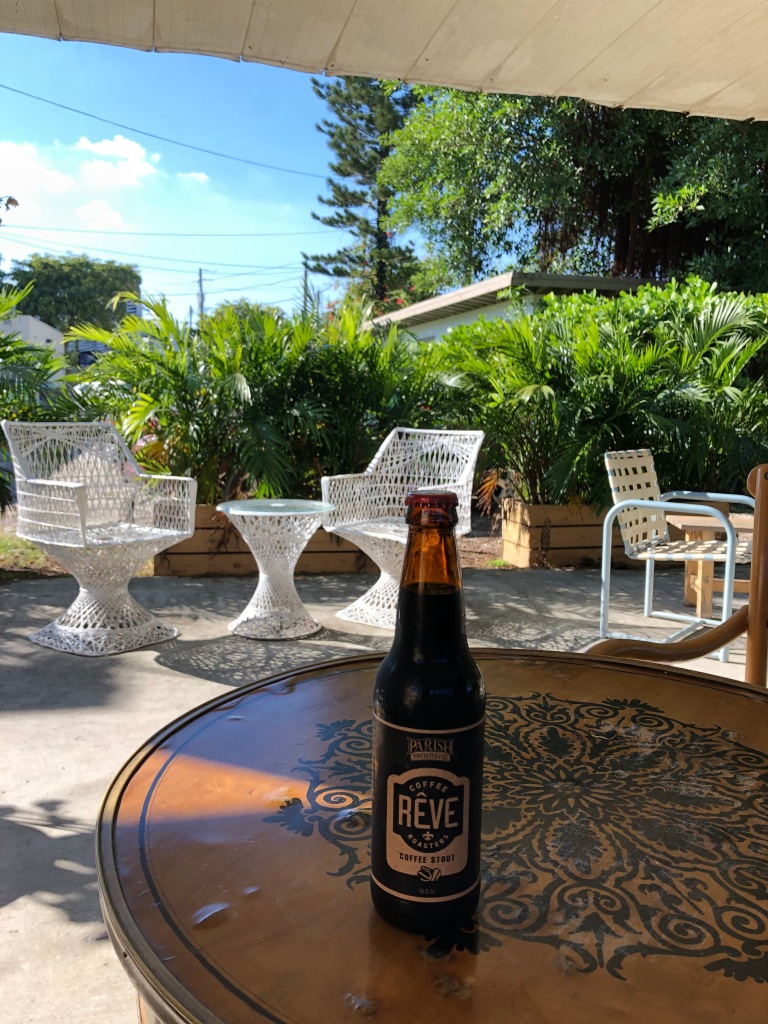
Student Bio
Howdy! My name is Esmeralda Iyescas and I currently am a senior at Florida International University Honors College, majoring in Information Technology. Though I am a STEM major, I love the arts, cuisine, literature, and learning about new cultures. I was born and raised in Miami, Florida but my background is Franco-Nicaraguan. Prior to taking Miami in Miami, I would liked to have considered myself as someone who was familiar with their hometown, but I soon realized, there is much of Miami that I took for granted. There is a rich history and many stories that come to life when you uncover Miami’s past. Part of my mission to reconnect with Miami, I chose to learn and research Little Havana since its a neighborhood I am not familiar with. Nonetheless, I spent a lot of time in the area to discover its history and beauty.
Geography

Little Havana, also known as La Pequena Havana, is a neighborhood located in North-East Miami. This area of Miami is also referred to as Calle Ocho since many of its famous landmarks can be found along this strip. Little Havana has an elevation of 10 feet above sea level which is approximately a 4 feet difference from the average elevation for Miami. To the left of Little Havana is West Flagler and to the right is Riverside and Downtown. The neighborhoods like West Flagler, Fountainbleau, or Westchester that are all located west of Little Havana are other areas in Miami whose populations are primarily made up by the Latin community.
Little Havana is split up into three sections, East Little Havana, Central Little Havana, and East Little Havana.
History
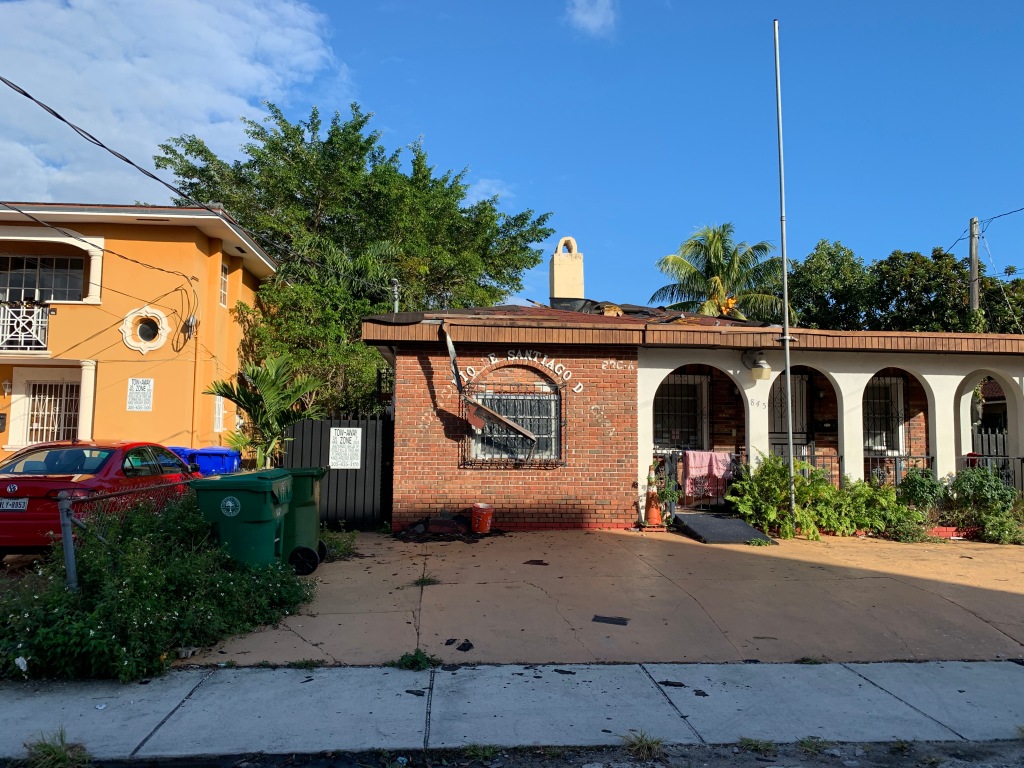
Little Havana originally was a prominent Jewish and Greek neighborhood but around the late 1950s through mid 1960s, Cuban immigrants began moving into the area. They slowly started incorporating their culture to the neighborhood changing the dynamic. Since the community did not want to lose the Cuban and Latin culture, they decided to create a “Latin Quarter” to diversify the city.
There was a problem with Little Havana, the architecture did not reflect the prominent Cuban culture. Renovations were done and began adding palm trees and building homes and businesses with Mediterranean and Spanish influences (like the photo shown above.) In addition, they made 9th street through 1st street look like a typical Havana neighborhood.
With all the renovations and Cuban immigrants, they began opening mom-and-pop shops and other businesses to allow the neighborhood to blossom. A notable difference from the shops in Little Havana from other parts of Miami at the time was that the owners were only Spanish speaking. Many did not learn the language and created a prominently Spanish speaking community where all the immigrants could feel at home.
The City of Miami recognized Little Havana as a culturally rich neighborhood and in order to preserve the changed they created guideless for new business in the area. The guidelines entailed having new buildings to match the Mediterranean and Spanish architecture and to incorporate culturally relevant and accurate renovations. In addtion, the City would held provide funding and find grants for these changes to be done to Little Havana. An example of these renocations was the murals and other art works that were added to the McDonalds located on 8th Street and 14th Ave.
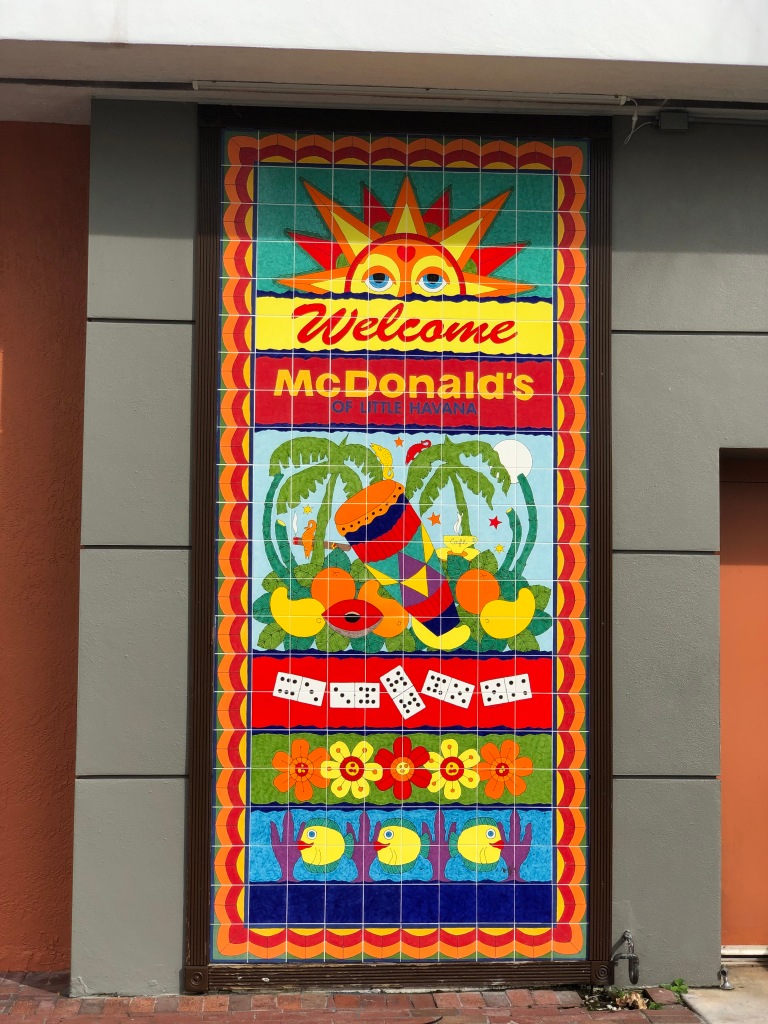
Demographics
The demographic recorded Point2homes 75% of the population is not US born and 42% of those people are not citizens of the United States. In addition, nearly 90% of the residents are Hispanic or Latino and the rest consisting of Black Americans or Non-Hispanic White according to the StatisticalAtlas. The 90% is majority Cuban followed by Nicaraguans and Hondurans. The median age is 43 and the population is evenly split between females and males.
The median household income is $27,000 and the average household income being $41,000. It is important to note that the average household has three people. The education statistics for Little Havana almost 50% of citizens having some high school education and the next majority having no high school education. This reflects how the majority of occupations in Little Havana begin with construction and facilities.
Little Havana is the first most populated neighborhood and the second most dense neighborhood in Miami. This would explain the large conglomeration of people and heavy congestion in the streets of the neighborhood.
Interview with Little Havana Resident:
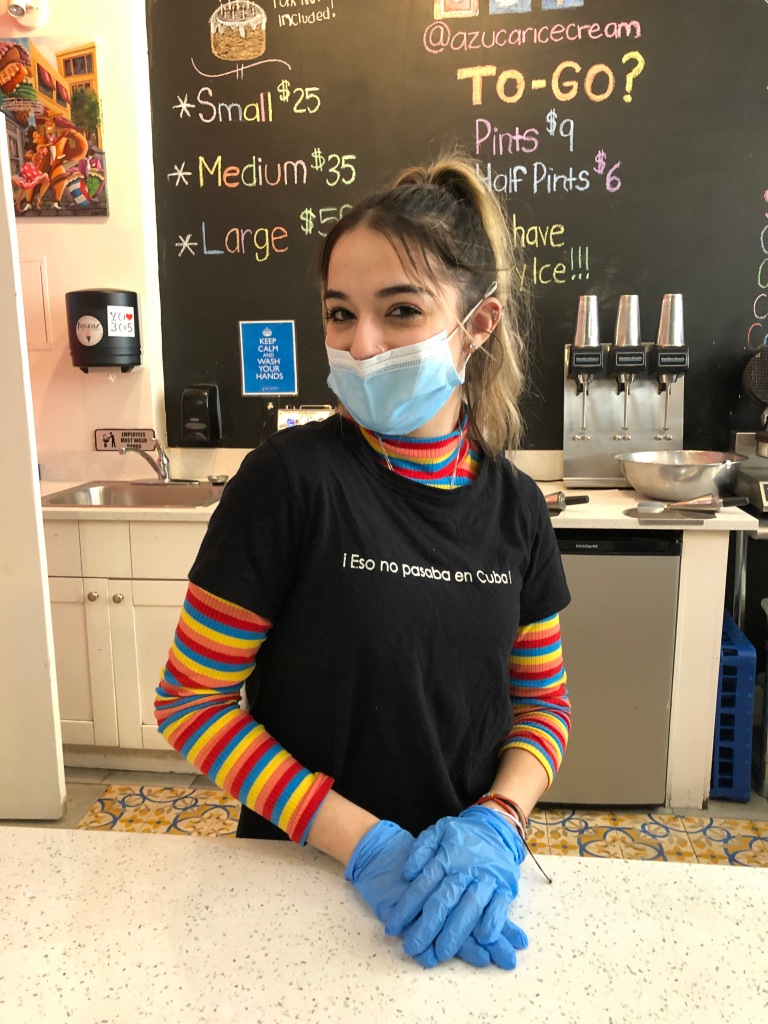
Valerie is currently a student with a part time job at Azucar. She lives in the area and has lived there her entire life. I spoke with Valerie in order to get information on Little Havana that I would not have been able to Google.
E: Can you please give me a small introduction of yourself?
V: I am a student, I have been working here (at Azucar) for about a year and half, and consider myself outgoing and bubbly.
E: What brought you to Little Havana?
V: My grandparents were the first ones to come from Cuba. And they have been here ever since.
E: How would you describe Little Havana?
V: Very friendly, you see new people everyday, the area is very diverse and cultural.
E: Favorite thing about living in Little Havana?
V: I was raised here and so the locals know each other and will greet one another everyday. Everyone is always so friendly and makes it enjoyable to live in the area.
Landmarks
Ladies in White:

Ladies in white is a mural that was painted by a young artist local artist, Daniel Fila. He created this mural to tribute a non-violent movement that started in Cuba during the early 2000s. The movement was called “Damas de Blanco” (or Ladies in White) because after 75 women were arrested in Havana, Cuba for publicly challenging the Cuban government, other women supports would dress in all white each Sunday to march down the streets of Havana. The artist wanted to recognize the brave women who fought and encouraged respect for all human rights. The freedom we may take for granted is one that must be fought for in places such as Cuba, where voices are silenced and oppressed.
J.W. Warner House:

The J.W. Warner House is the only location that has been added to the “U.S. National Register of Historical Places” in Little Havana. The house was recognized as a historical place because it was built in 1912 and was built with primarily a neoclassical style with subtle but different architectural accents. In addition to its architecture, the house is also recognized because continues to stand tall over century later. The reason for this because during the original construction in 1906, a hurricane that hit and the Warmers decided to reinforce the wood with concrete.
James Warner came to Miami with a passion for flowers and as an employee for Flagler. James Warner’s wife, Susan, loved flowers and started to make floral arrangements for close family and friend. Quickly, her little endeavor blossomed into a successful business, the Miami Floral Company.
Cubaocho Museum:
The Cubaocho museum embodies everything Cuban — art, mojitos, live music, cigars, and lively night ambience. Upon entering the museum, your eyes cannot help but bounce across the room because since there is so much to see, it is hard to focus on only one item. There is a lot of truly magnificent pieces of art and furniture in the museum. The bartender notified me that every single item in the museum is for sale. Remember: “Everything has a price”.
The Cubaocho museum starts to become alive towards the evening and stays open all through the night. The owners wanted to introduce a very typical Cuban nightlife to Miami, where people from all ages can come and enjoy a couple drinks with live music and cigar to top off the night. Even for those who may not be interested in drinking, smoking, or lively music, the art works that is housed within the museum is worth admiration. The murals that surround the premise are also decorated to promote Cuban culture and Cuban artists from the local community.
Plaza De La Cubanidad:
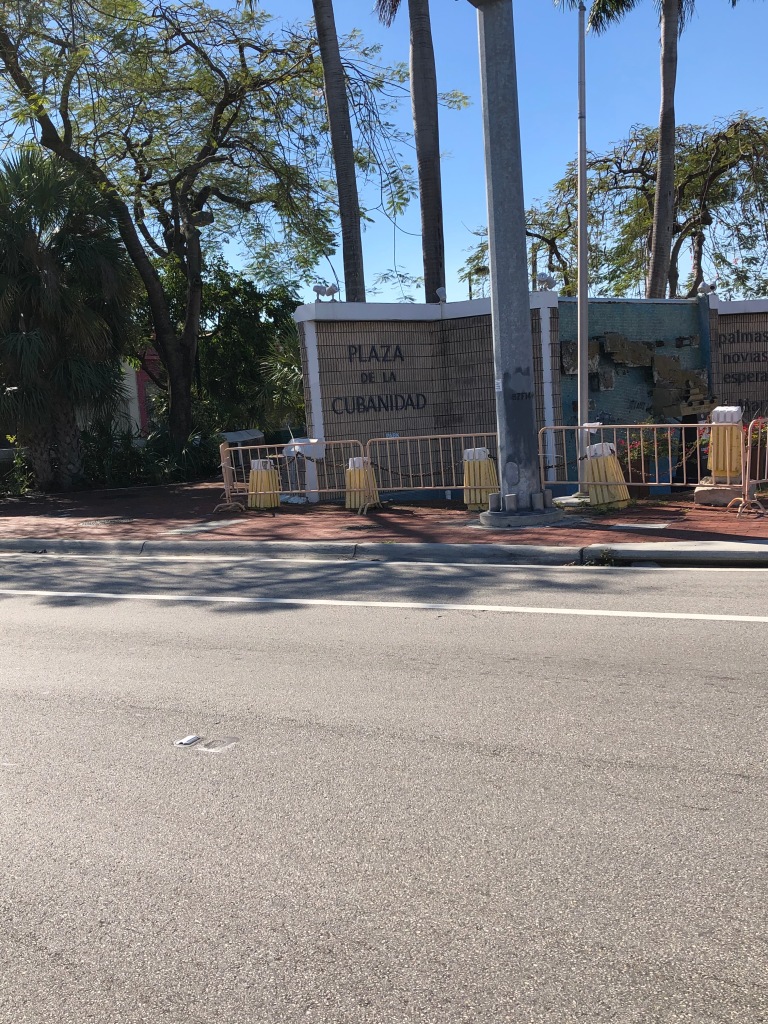
Plaza de la Cubanidad uses Spanish wordplay by combining the two words “Cuban” and “comunidad” (which means community) to come to “Cubanidad”. La Plaza de la Cubanidad stands at the center of Little Havana greeting all the visitors and residents who pass the intersection on West Flagler Street and NW 17th AVE. The landmark is symbolic to Cuban culture because it acts as small centre and memorial to remember and recognize Cuban refugees who died trying to escape their homeland. The small mural reminds us how fortunate we, Americans, are to live freely in a country and leave at free will without risk of being killed.
Green
Bay of Pigs Memorial Park:
The Bay of Pigs Memorial Park was created to recognized the brave soldiers that died during the Bay of Pigs invasion. The Bay of Pigs invasion occurred because the United States wanted to help Cuban exiles overthrow Fidel Castro’s regime. The Cubans who opposed Fidel Castro’s revolution were trying attempting to take back Cuba from the hands of their oppressor. Many young men lost their lives or were imprisoned from the invasion. Since the invasion was hosted by the United States in collaboration with Cuba, Little Havana decided to create a monument to commemorate the brave efforts from the valiant soldiers.
The Kapok tree that is depicted in the fourth picture, is very important to the park because to the Afro-Cuban culture, the tree is considered as sacred. The tree is considered sacred because it was said that they housed the spirts of their ancestors. The kapok tree is used an alter for the Santeria belief. The Santeria believers will use the tree to offer fruits and other items to the gods.
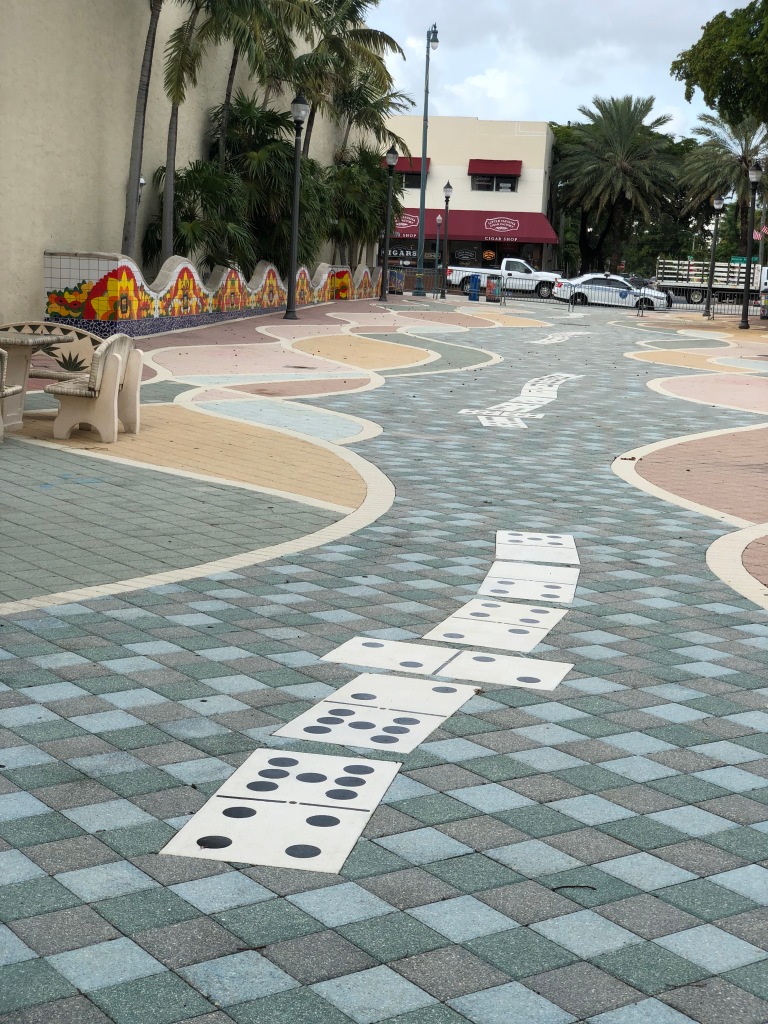
Domino Park or Maximo Gomez Park is located in the center of the 8th street strip in Little Havana. It was constructed in 1976 and has thrived since its opening. The park is primarily occupied as a social spot for retired Cuban locals to socialize and talk about politics while they play dominoes with a cafecito on the side. Domino park is unfortunately closed to the current pandemic but otherwise, this area would be filled from dawn until dusk.
Jose Marti Park
Jose Marti Park is a park that is located on the most eastern part of Little Havana that runs along the Miami River. The park is named after Jose Marti who was a very famous Cuban poet who encouraged Cubans to rebel against the repressive regime. He spread his democratic and freedom oriented ideologies.
Something I appreciate greatly about the park is the mural they have on one of the children’s section is a mural with a very famous quote that says “Los ninos son la esperanza del mundo” or “Children are the hope of the world.” It is a very beautiful quote that was taken from a piece of poetry that Jose Marti wrote.
Transportation
The city of Miami has been known to have a big transportation issue considering its density. Therefore, Miami suffers from a lot of congestion and heavy traffic most of day, which makes transportation by automobile difficult. Being that Calle Ocho (8th street) is located in Little Havana, this makes transportation particularly more difficult and less effective. Public transportation has been a growing issue for Miami and affects most neighborhoods in the city due to its limitations. For example, considering Little Havana’s geographical location, the Metrorail goes around the neighborhood, making it out of reach for the residents there. The nearest stop is Coconut Grove station if coming from the south, but coming from the west there are more options, but nonetheless, all being rather from the neighborhood.
Trolley/ Metrobus

The next option the residents have for public transportation is between the Metrobus and a trolley that passes through the area. The trolley route that is designed specifically for the Little Havana neighborhoods only loops around 1st street and 8th street. The reason for this design is because the concentration of tourists and businesses are along these two streets making the trolley most effective for these two strips. On the other hand, the Metrobus has many different lines that connect with each other, and that stop at different Metrorail stations. The only downside is the traffic slows down the efficiency of the transportation, but at least the options are available for the residents of the neighborhood.
Personal motorized vehicles
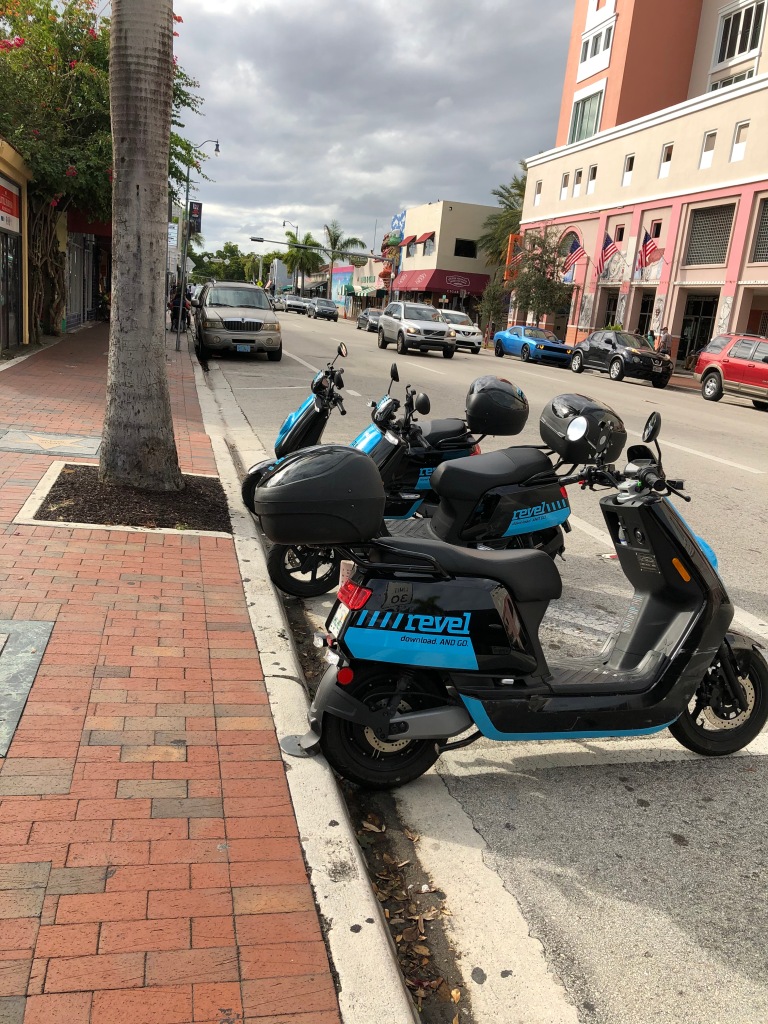
The other option for transportation is of private means, automobiles, motorized bikes, scooters, ect. These means for transportation are used much more around and in the neighborhood because of convenience, comfort, and efficiency. According the the reported demographics for Little Havana, personal cars are the most popular and most used form of transportation.
Scooters and other small vehicles makes transportation ideal in Little Havana because the streets are narrow and constantly packed. Manuevering the steets in a smaller vehicle permits easier parking and facilities commutes during times of high congestion.
Walking/ Biking
The last transportation option is biking and walking. This form of transportation is less ideal in this part of Miami because the Little Havana is widespread and covers a large surface area. The demographics show that walking and biking is one of the smallest forms of transportation when compared to commuting by car or bus/trolley.
Eateries
Azucar, otherwise known as Sugar in English, is an artisan ice cream parlor located on Little Havana’s 8th street strip. The owners were inspired by Miami’s diverse cultures and wanted to represent it in their ice cream boutique. South Florida is like their parlor that many different flavors have come together harmoniously regardless of the different background and cultures. Azucar is a beautiful ice cream boutique that has incorporated the Latin culture flawlessly. Upon walking in, you notice their cushions are made from the guayaberas that are very prominent in Cuban cultures (picture shown above). Next, their flavors options are widespread and named after famous American and Latin Stars, different Spanish colloquial sayings or common Spanish exotic fruits. I must say, I am not a big fan of sweet treats, but the ice cream served at Azucar is top-notch. I was blown away by the freshness of the ice cream! I would recommend it to any local or tourist that has the opportunity of taking a small trip to Little Havana.
Versailles Restaurant Cuban Cuisine:
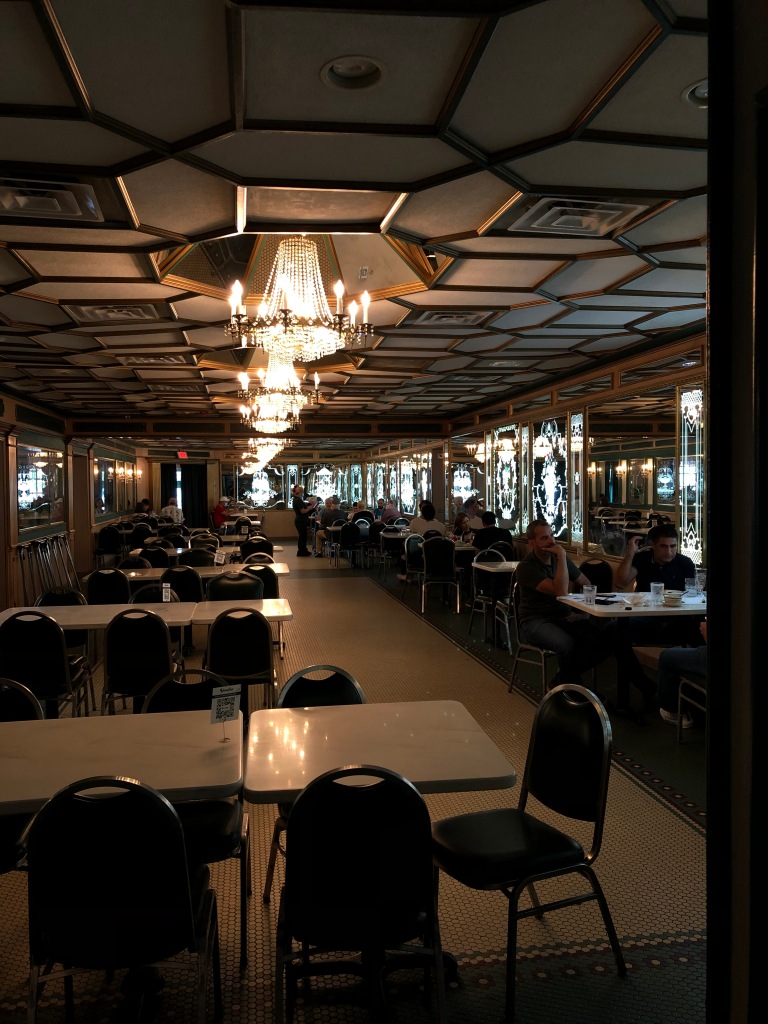
Versailles Restaurant is one of Miami’s most popular restaurants since it was built during an important time for Cubans. The restaurant was built in 1971, making it one of the oldest Cuban restaurants in the country. In addition to old, the Cubans found Versailles to be a safe place because it was said to be where Cuban exiles convened to discuss Cuba’s regime and political leader, Fidel Castro. However, Versailles is meant to be a take on the Palace of Versailles in France.
Dude to the current pandemic, I decided to eat outside so I was not able to appreciate the interior design and decorations of the restaurant. I did however, go inside once before leaving, and I must say that the restaurant is impressive. The area that particularly caught my attention was hall whose walls were covered in mirrors and the ceiling had a row of chandeliers. It reminded me much of the Hall of Mirrors at the original royal Palace of Versailles which had a whopping 357 mirrors!
La Esquina de la Fama:
La Esquina de la Fama translates to “Corner of Fame” in English. This restaurant reminds me much of the Cubaocho Museum because of the historical new clippings and the manner in which it is decorated on the inside. When walking into the restaurant, it felt much like walking into a museum because I could see and feel the Cuban presence. There is a famous culinary tour guide in Miami hosted by Grace Della and she takes locals and tourist around Little Havana to show them the Latin Quarter. One of the places where she religiously stops for an empanada on her tours is La Esquina de la Fama. I can personally say that their empanadas were to die for. It was truly one of the best fried empanadas I have had in a very long time. In addition, their ham croquetta was probably the best I have ever had in my life. I could genuinely taste the ham and the balance between crispness and softness was beautiful.
Businesses
Cuba Tobacco Cigar Co:
Cuba Tobacco Cigar Company was the first cigar shop to open in Little Havana over 40 years ago. The cigars are made the same way as they did when the business first opened. I spoke with one of the knowledgeable employees of this cigar shop, and he informed me that they used the same tobacco leaves, which originated in Nicaragua. Each cigar is hand rolled with care and packaged to sell. The cigars range from $2-$400 depending on what you are looking for.
Los Pinarenos, Fruteria:

Los Pinarenos Fruteria is an outdoor market that sells fresh fruits, grains, and vegetables that are not found commonly in traditional supermarkets. Like many other shops in Little Havana, this market is a genuine mom-and-pop shop that has been around for more than 50 years! In this fruit market, the owners are very adamant about only selling fresh fruits and vegetables that (if possible) are grown and harvested locally. In addition, they sell many fruits and items that would be typically bought in a fruit market in Cuba, making it easy for residents to continue cooking authentic Cuban cuisine at home.
Union Beer Store:
Union Beer Store is a small mom-and-pop shop where they sell exclusive craft beers. I had the pleasure of meeting David, the founder and owner of the store, and he shared how dedicated they are in only serving the best craft beers in town. Many of the beers they sell are brewed locally in order to help support the breweries in the community. Due to the pandemic, they have expanded their beer bar to include an outdoor seating area that truly is enjoyable. Though our current health and social circumstances have impeded sales and traffic, the quality of beer severed along with the ambiance makes it a one-of-a-kind experience!
Summary
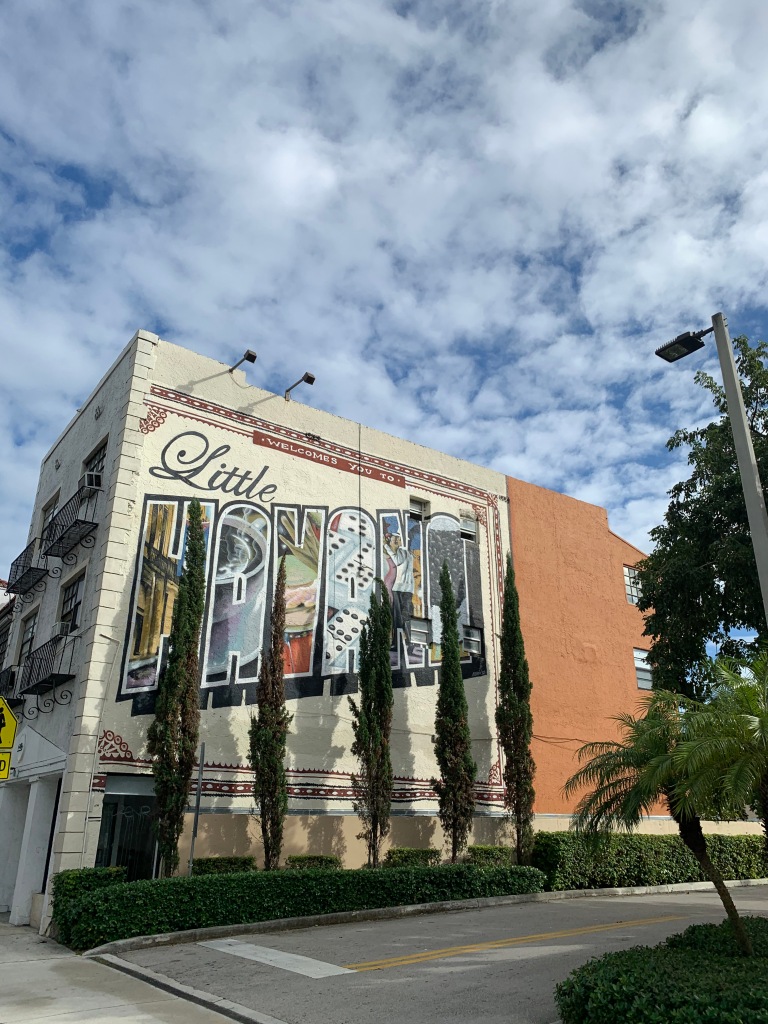
Little Havana is a very rich neighborhood with a lot of history and Latin flavor. Walking the streets of Little Havana after learning about Cuba and Miami’s history enriched my experience and allowed me to admire Cuban and Latin culture. I would most definitely recommend any local or tourist to visit Little Havana. Though Miami is known for the beaches and the lively nightlife, Miami should be recognized more often for the important cultural influences that have given by the immigrants who reshaped the city.
I think everyone should pay a visit to Little Havana because it really is unlike any neighborhood in Miami!
Citations
admin, Posted By: “The Warner House.” Miami History Blog, 29 Sept. 2020, miami-history.com/the-warner-house/.
City of Miami. “City of Miami – Official Website.” City of Miami Miami Trolley, 2020, archive.miamigov.com/trolley/information.html.
“Connecting the Upper, Middle, and Lower Maya Realms.” ThoughtCo, 29 Mar. 2019, http://www.thoughtco.com/ceiba-pentandra-sacred-tree-maya-171615.
C-SPAN. “Little Havana.” C-SPAN, uploaded by C-SPAN, 21 Feb. 1994, www.c-span.org/video/?54753-1/havana.
“Ladies in White.” Wikipedia, Wikimedia Foundation, 29 July 2020, en.wikipedia.org/wiki/Ladies_in_White.
“Little Havana Demographics.” Point2, http://www.point2homes.com/US/Neighborhood/FL/Little-Havana-Demographics.html.
“Little Havana.” Wikipedia, Wikimedia Foundation, 5 Oct. 2020, en.wikipedia.org/wiki/Little_Havana.
“Little Havana Topo Map in Miami-Dade.” TopoZone, 23 Dec. 2015, www.topozone.com/florida/miami-dade-fl/city/little-havana.
Martinez, Nicole. “Behind the Legacy of Little Havana’s Cuba Tobacco Cigar Co. in Miami.” Culture Trip, The Culture Trip, 9 Aug. 2019, theculturetrip.com/north-america/usa/florida/articles/little-havana-and-the-cuba-tobacco-cigar-factory/.
“Miami’s Cuban Cuisine Palace.” Versailles. 18 Oct. 2012. Web. 12 Dec. 2020.
“Race and Ethnicity in Little Havana, Miami, Florida (Neighborhood).” The Demographic Statistical Atlas of the United States – Statistical Atlas, statisticalatlas.com/neighborhood/Florida/Miami/Little-Havana/Race-and-Ethnicity.
Rupersburg, |By Nicole. “Don’t Call It Graffiti: Daniel Fila Is a Professional Fine Artist Who Paints Murals All over Miami.” Creative Exchange. 29 July 2016. Web. 12 Dec. 2020.
Whitefield, Mimi. “Cuba’s Ladies in White Win $250,000 Prize for Advancing Liberty.” Miamiherald. Miami Herald, 18 May 2018. Web.
Wikipedia contributors. “List of Neighborhoods in Miami.” Wikipedia, 31 Oct. 2020, en.wikipedia.org/wiki/List_of_neighborhoods_in_Miami#/media/File:Miami_neighborhoodsmap.png.


